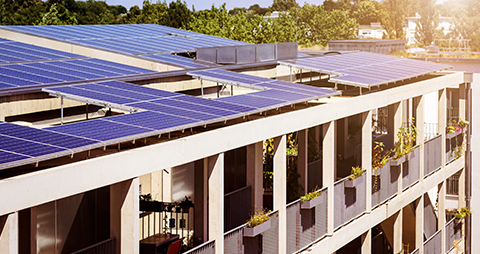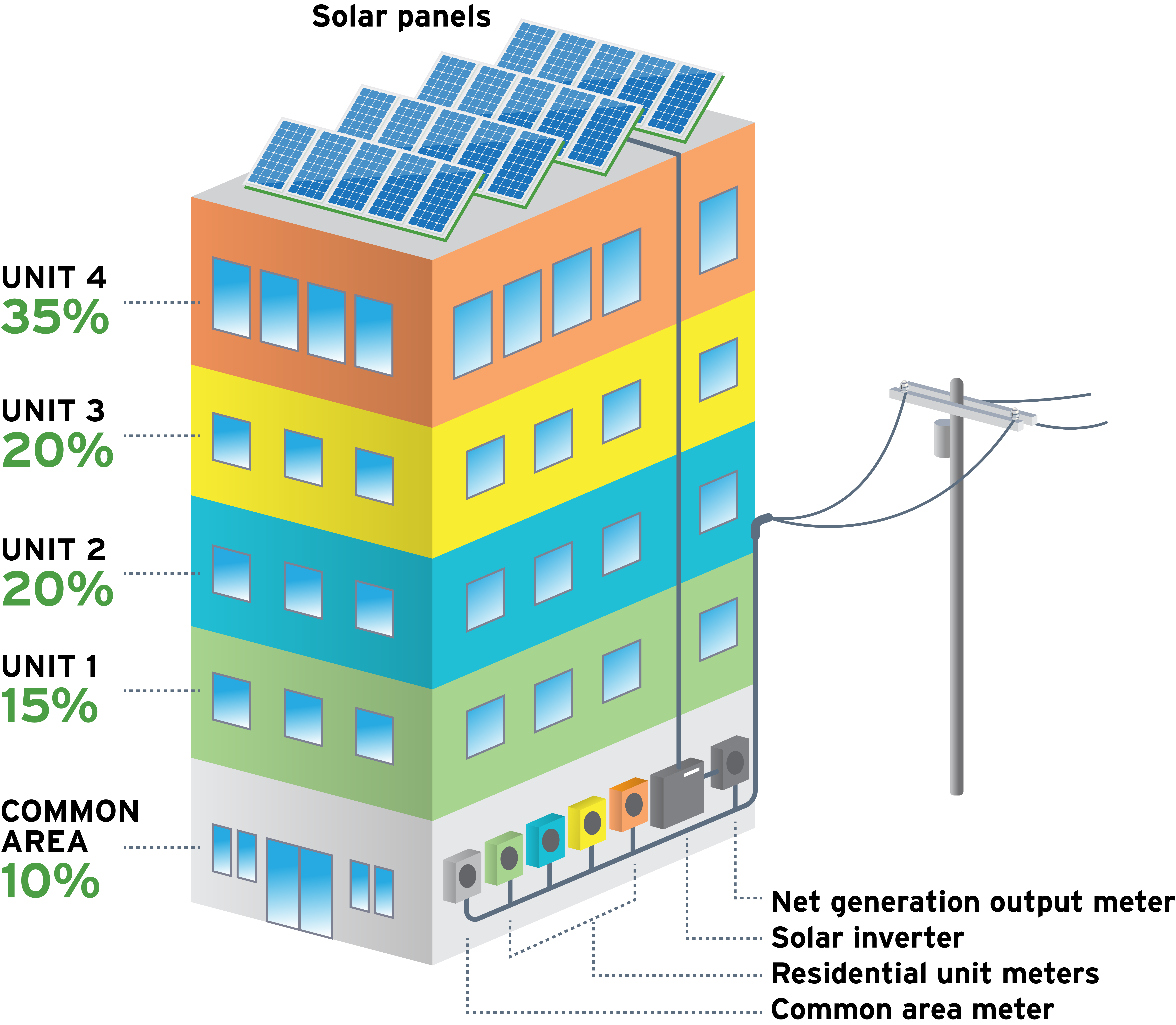Virtual Solar Billing Plan (VSBP)
Supporting California's Clean Energy Goals

How the Virtual Solar Billing Plan works
The Virtual Solar Billing Plan (VSBP) allows several customers to share a single solar system. The plan is for properties with many tenants, like apartment complexes and office buildings.

Here’s an example of Virtual Solar Billing:
The owner of this four-unit apartment building installed a solar system. Each of the four units plus the common area receives a portion of the solar system’s output each month.
In this example, the building owner has assigned the tenant living in Unit 3 to receive 20% of the solar system’s output. If Unit 3’s portion (20%) of the solar system sends more energy (exports) to the grid than it uses (imports), the tenant will receive export credits to offset their bill.
Although the building’s total usage is calculated through a single meter, tenants still receive an individual bill that’s due each month that highlights charges and credits.
VSBP Fact Sheet
Provided as a resource for owners and property managers, this downloadable fact sheet gives an overview of Virtual Solar Billing and can be shared with tenants to help them better understand their billing.
Virtual Solar Billing Plan FAQs
Your account is transitioning to the Virtual Solar Billing Plan because your solar system has reached the end of its 9-year Virtual Net Energy Metering (VNEM) legacy period. Note: If you recently moved into a property that has solar, the VNEM legacy period began when the solar panels were initially installed and interconnected.
In a Virtual Solar Billing Plan setup, there are two types of accounts: generating account and benefiting accounts.
- A generating account is for the meter that is directly attached to the solar system. For example, a generating account customer could be the owner of a multi-unit apartment complex that has solar panels.
- A benefitting account is one or more accounts that receive a portion of the export credits from the shared solar system. For example, benefitting account customers could be the tenants of the apartment building who benefit from the solar energy produced.
To check if your account is benefiting from solar, visit My Energy Center to access your billing information. Download your Solar Bill and look for export credits on this bill.
- CCA Customers: Locate the “Electric Charges and Credits" section to see any eligible Delivery Export Credits and the “CCA Electric Generation Charges" section to see any eligible Generation Export Credits. Please contact your CCA for questions about Generation Export Credits.
- Non-CCA Customers: Locate the “Electric Charges and Credits" section to see any eligible Delivery Export Credits and Generation Export Credits.
- Residential customers have their electricity imports and exports (kWh) netted in 15-minute intervals. For any 15-minute interval where a customer is a net importer, the customer will be charged the appropriate retail rate for that interval. For any 15-minute interval where a customer is a net exporter, the customer is credited for excess energy generation at the appropriate ACC rate.
- These interval charges and credits are then totaled and netted at time of billing. This new VSBP method of allocating and crediting kWh – is designed to provide VSBP customers the benefits of standard rooftop solar.
- Commercial customers are charged based on the total of their import charges and export credits in a given bill period. These dollar amounts are then netted at time of billing. kWh is not netted for commercial customers.
Customers receive export credits for the energy their portion of the solar system sends to the grid. Credits are calculated based on the value of energy at that time of day. Export credits are split into two categories: Generation Export Credits and Delivery Export Credits.
Generation Export Credits can only be used to offset Generation Import Charges, while Delivery Export Credits can only be used to offset Delivery Import Charges. If you’re a CCA customer, contact your CCA for more information about your generation credits.
As a Virtual Solar Billing Plan customer, your bill is due monthly.
Residential customers may take service on any eligible Time-of-Use (TOU) pricing plan. Commercial customers may take service on any eligible pricing plan.
Log in to MyEnergyCenter.com to view available pricing plans and choose the right plan for your home or business.
As a VSBP customer, you receive a monthly bill along with an annual true-up bill at the end of each 12-month period. If you exported more than you imported throughout your entire true-up period, your true-up bill will reflect an Annual
True-Up Adjustment charge or credit.
The True-up Adjustment accounts for changes in export pricing that happen throughout the year. If you imported more than you exported during the 12-month period, no adjustment is necessary, and this amount will be zero.
After you receive your true-up bill, your account is automatically reset for a new 12-month period. Any Generation or Delivery Export Credits remaining at the time of true-up, will carry over indefinitely until the credits are used or until you end service.